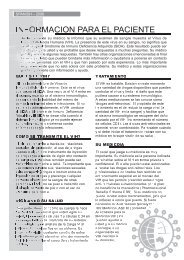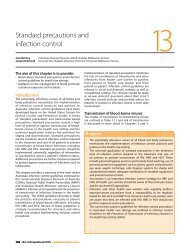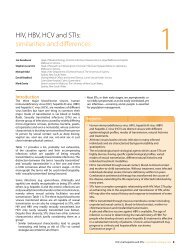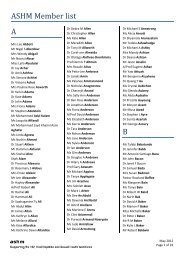B Positive – all you wanted to know about - ASHM
B Positive – all you wanted to know about - ASHM
B Positive – all you wanted to know about - ASHM
Create successful ePaper yourself
Turn your PDF publications into a flip-book with our unique Google optimized e-Paper software.
8 Managing patients with advanced liver disease<br />
progression of the disease. interferon-based<br />
therapies are contra-indicated in patients with<br />
decompensated cirrhosis, but oral antiviral<br />
agents are gener<strong>all</strong>y very well <strong>to</strong>lerated.<br />
2. Reducing other hepatic insults<br />
<strong>all</strong> patients should have a detailed his<strong>to</strong>ry and<br />
examination performed <strong>to</strong> establish:<br />
� underlying medical conditions, including<br />
co-infection with hepatitis c, hepatitis d or<br />
the human immunodeficiency virus (HiV).<br />
� Medication use<br />
� Prescribed<br />
� alternative or complementary medicine<br />
and over-the-counter drugs<br />
� <strong>to</strong>bacco use<br />
� alcohol use<br />
� recreational drug use<br />
� family his<strong>to</strong>ry of liver disease, diabetes<br />
� Weight, body mass index (bMi)<br />
� evidence of diabetes or other organ system<br />
disease.<br />
Patients with advanced liver disease should<br />
have <strong>all</strong> co-existing disorders addressed as far<br />
as possible, in addition <strong>to</strong> having the primary<br />
disease and its complications managed.<br />
specific<strong>all</strong>y, weight reduction when obesity is an<br />
issue and cessation of alcohol use (or markedly<br />
reducing alcohol consumption if abstinence<br />
is not an option) are critical processes in the<br />
management of this group of patients. Patients<br />
should also avoid excessive use of paracetamol<br />
and non steroidal anti-inflamma<strong>to</strong>ry therapy.<br />
drugs <strong>know</strong>n <strong>to</strong> cause liver disease should<br />
be used with caution, although underlying<br />
liver disease does not increase the risk of side<br />
effects.<br />
Having advised the patient <strong>about</strong> other fac<strong>to</strong>rs<br />
that can aggravate liver disease, the clinician<br />
must then focus on a specific management<br />
plan for advanced liver disease.<br />
3. Managing the complications of<br />
advanced liver disease<br />
it is important <strong>to</strong> document the extent of liver<br />
disease through a detailed his<strong>to</strong>ry and clinical<br />
examination. it is imperative that the patient is<br />
regularly reviewed in the same detailed manner,<br />
66 b <strong>Positive</strong> <strong>–</strong> <strong>all</strong> <strong>you</strong> <strong>wanted</strong> <strong>to</strong> <strong>know</strong> <strong>about</strong> hepatitis b: a guide for primary care providers<br />
as the disease process evolves over time. in<br />
the initial examination, the patient’s his<strong>to</strong>ry,<br />
his/her examination and <strong>all</strong> investigations are<br />
required <strong>to</strong> document or rule out the following<br />
conditions:<br />
� Chronic liver disease<br />
� Hepa<strong>to</strong>splenomegaly<br />
� spider naevi<br />
� Hepatic palms (palmar erythema)<br />
� Hepatic lunules (changes at nail base)<br />
� Loss of body hair distribution in men<br />
� Hirsutism in women<br />
� testicular atrophy<br />
� Fluid and electrolyte balance problems<br />
� oedema<br />
� ascites, pleural effusion<br />
� decreased urine output<br />
� Hyponatraemia<br />
� Hypo/hyperkalaemia<br />
� rising creatinine<br />
� Portal hypertension<br />
� Hepa<strong>to</strong>megaly and splenomegaly<br />
� collateral vessels on anterior abdominal<br />
w<strong>all</strong><br />
� caput medusae<br />
� ascites<br />
� overt or occult gastrointestinal<br />
haemorrhage<br />
� Portal systemic encephalopathy (Pse)<br />
� Varices (evidence by ultrasound, computed<br />
<strong>to</strong>mography or endoscopy)<br />
� Portal systemic encephalopathy<br />
� reversed sleep pattern (day time<br />
somnolence and nocturnal waking)<br />
� Metabolic flap or asterixis<br />
� slowing of normal response times,<br />
reflexes<br />
� impaired driving skills<br />
� Lack of energy<br />
� confusion<br />
� increasing drowsiness<br />
� coma<br />
� Advancing hepatic decompensation<br />
� anorexia<br />
� Jaundice<br />
� bruising and bleeding problems<br />
� spontaneous bacterial peri<strong>to</strong>nitis<br />
� Metabolic bone disease and risk of<br />
fractures<br />
� impaired glucose homeostasis<br />
� impaired renal function






